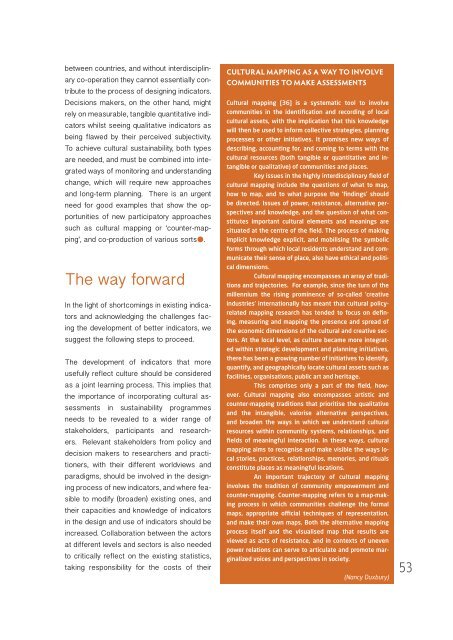Culture in for and as Sustainable Development
YIGflg
YIGflg
Create successful ePaper yourself
Turn your PDF publications into a flip-book with our unique Google optimized e-Paper software.
etween countries, <strong>and</strong> without <strong>in</strong>terdiscipl<strong>in</strong>ary<br />
co-operation they cannot essentially contribute<br />
to the process of design<strong>in</strong>g <strong>in</strong>dicators.<br />
Decisions makers, on the other h<strong>and</strong>, might<br />
rely on me<strong>as</strong>urable, tangible quantitative <strong>in</strong>dicators<br />
whilst see<strong>in</strong>g qualitative <strong>in</strong>dicators <strong>as</strong><br />
be<strong>in</strong>g flawed by their perceived subjectivity.<br />
To achieve cultural susta<strong>in</strong>ability, both types<br />
are needed, <strong>and</strong> must be comb<strong>in</strong>ed <strong>in</strong>to <strong>in</strong>tegrated<br />
ways of monitor<strong>in</strong>g <strong>and</strong> underst<strong>and</strong><strong>in</strong>g<br />
change, which will require new approaches<br />
<strong>and</strong> long-term plann<strong>in</strong>g. There is an urgent<br />
need <strong>for</strong> good examples that show the opportunities<br />
of new participatory approaches<br />
such <strong>as</strong> cultural mapp<strong>in</strong>g or ‘counter-mapp<strong>in</strong>g’,<br />
<strong>and</strong> co-production of various sorts .<br />
The way <strong>for</strong>ward<br />
In the light of shortcom<strong>in</strong>gs <strong>in</strong> exist<strong>in</strong>g <strong>in</strong>dicators<br />
<strong>and</strong> acknowledg<strong>in</strong>g the challenges fac<strong>in</strong>g<br />
the development of better <strong>in</strong>dicators, we<br />
suggest the follow<strong>in</strong>g steps to proceed.<br />
The development of <strong>in</strong>dicators that more<br />
usefully reflect culture should be considered<br />
<strong>as</strong> a jo<strong>in</strong>t learn<strong>in</strong>g process. This implies that<br />
the importance of <strong>in</strong>corporat<strong>in</strong>g cultural <strong>as</strong>sessments<br />
<strong>in</strong> susta<strong>in</strong>ability programmes<br />
needs to be revealed to a wider range of<br />
stakeholders, participants <strong>and</strong> researchers.<br />
Relevant stakeholders from policy <strong>and</strong><br />
decision makers to researchers <strong>and</strong> practitioners,<br />
with their different worldviews <strong>and</strong><br />
paradigms, should be <strong>in</strong>volved <strong>in</strong> the design<strong>in</strong>g<br />
process of new <strong>in</strong>dicators, <strong>and</strong> where fe<strong>as</strong>ible<br />
to modify (broaden) exist<strong>in</strong>g ones, <strong>and</strong><br />
their capacities <strong>and</strong> knowledge of <strong>in</strong>dicators<br />
<strong>in</strong> the design <strong>and</strong> use of <strong>in</strong>dicators should be<br />
<strong>in</strong>cre<strong>as</strong>ed. Collaboration between the actors<br />
at different levels <strong>and</strong> sectors is also needed<br />
to critically reflect on the exist<strong>in</strong>g statistics,<br />
tak<strong>in</strong>g responsibility <strong>for</strong> the costs of their<br />
CULTURAL MAPPING AS A WAY TO INVOLVE<br />
COMMUNITIES TO MAKE ASSESSMENTS<br />
Cultural mapp<strong>in</strong>g [36] is a systematic tool to <strong>in</strong>volve<br />
communities <strong>in</strong> the identification <strong>and</strong> record<strong>in</strong>g of local<br />
cultural <strong>as</strong>sets, with the implication that this knowledge<br />
will then be used to <strong>in</strong><strong>for</strong>m collective strategies, plann<strong>in</strong>g<br />
processes or other <strong>in</strong>itiatives. It promises new ways of<br />
describ<strong>in</strong>g, account<strong>in</strong>g <strong>for</strong>, <strong>and</strong> com<strong>in</strong>g to terms with the<br />
cultural resources (both tangible or quantitative <strong>and</strong> <strong>in</strong>tangible<br />
or qualitative) of communities <strong>and</strong> places.<br />
Key issues <strong>in</strong> the highly <strong>in</strong>terdiscipl<strong>in</strong>ary field of<br />
cultural mapp<strong>in</strong>g <strong>in</strong>clude the questions of what to map,<br />
how to map, <strong>and</strong> to what purpose the ‘f<strong>in</strong>d<strong>in</strong>gs’ should<br />
be directed. Issues of power, resistance, alternative perspectives<br />
<strong>and</strong> knowledge, <strong>and</strong> the question of what constitutes<br />
important cultural elements <strong>and</strong> mean<strong>in</strong>gs are<br />
situated at the centre of the field. The process of mak<strong>in</strong>g<br />
implicit knowledge explicit, <strong>and</strong> mobilis<strong>in</strong>g the symbolic<br />
<strong>for</strong>ms through which local residents underst<strong>and</strong> <strong>and</strong> communicate<br />
their sense of place, also have ethical <strong>and</strong> political<br />
dimensions.<br />
Cultural mapp<strong>in</strong>g encomp<strong>as</strong>ses an array of traditions<br />
<strong>and</strong> trajectories. For example, s<strong>in</strong>ce the turn of the<br />
millennium the ris<strong>in</strong>g prom<strong>in</strong>ence of so-called ‘creative<br />
<strong>in</strong>dustries’ <strong>in</strong>ternationally h<strong>as</strong> meant that cultural policyrelated<br />
mapp<strong>in</strong>g research h<strong>as</strong> tended to focus on def<strong>in</strong><strong>in</strong>g,<br />
me<strong>as</strong>ur<strong>in</strong>g <strong>and</strong> mapp<strong>in</strong>g the presence <strong>and</strong> spread of<br />
the economic dimensions of the cultural <strong>and</strong> creative sectors.<br />
At the local level, <strong>as</strong> culture became more <strong>in</strong>tegrated<br />
with<strong>in</strong> strategic development <strong>and</strong> plann<strong>in</strong>g <strong>in</strong>itiatives,<br />
there h<strong>as</strong> been a grow<strong>in</strong>g number of <strong>in</strong>itiatives to identify,<br />
quantify, <strong>and</strong> geographically locate cultural <strong>as</strong>sets such <strong>as</strong><br />
facilities, organisations, public art <strong>and</strong> heritage.<br />
This comprises only a part of the field, however.<br />
Cultural mapp<strong>in</strong>g also encomp<strong>as</strong>ses artistic <strong>and</strong><br />
counter-mapp<strong>in</strong>g traditions that prioritise the qualitative<br />
<strong>and</strong> the <strong>in</strong>tangible, valorise alternative perspectives,<br />
<strong>and</strong> broaden the ways <strong>in</strong> which we underst<strong>and</strong> cultural<br />
resources with<strong>in</strong> community systems, relationships, <strong>and</strong><br />
fields of mean<strong>in</strong>gful <strong>in</strong>teraction. In these ways, cultural<br />
mapp<strong>in</strong>g aims to recognise <strong>and</strong> make visible the ways local<br />
stories, practices, relationships, memories, <strong>and</strong> rituals<br />
constitute places <strong>as</strong> mean<strong>in</strong>gful locations.<br />
An important trajectory of cultural mapp<strong>in</strong>g<br />
<strong>in</strong>volves the tradition of community empowerment <strong>and</strong><br />
counter-mapp<strong>in</strong>g. Counter-mapp<strong>in</strong>g refers to a map-mak<strong>in</strong>g<br />
process <strong>in</strong> which communities challenge the <strong>for</strong>mal<br />
maps, appropriate official techniques of representation,<br />
<strong>and</strong> make their own maps. Both the alternative mapp<strong>in</strong>g<br />
process itself <strong>and</strong> the visualised map that results are<br />
viewed <strong>as</strong> acts of resistance, <strong>and</strong> <strong>in</strong> contexts of uneven<br />
power relations can serve to articulate <strong>and</strong> promote marg<strong>in</strong>alized<br />
voices <strong>and</strong> perspectives <strong>in</strong> society.<br />
(Nancy Duxbury)<br />
53




